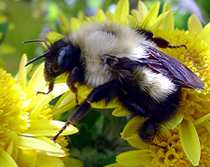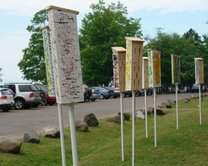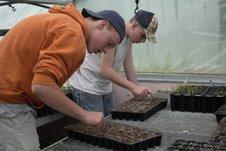 Millions of Monarchs will begin arriving in Mexico this week in an annual migration that includes thousands traveling through Michigan’s Upper Peninsula and some of the butterflies can thank Marquette and Native American teens for their future survival.
Millions of Monarchs will begin arriving in Mexico this week in an annual migration that includes thousands traveling through Michigan’s Upper Peninsula and some of the butterflies can thank Marquette and Native American teens for their future survival.
The Zaagkii Wings and Seeds Project in Marquette was created to protect pollinators like butterflies because billions of honeybees are dying across the world – especially in the Midwest – in a syndrome called “Colony Collapse Disorder.”
(Photo by Greg Peterson)
Marquette teens and youth from the the Keweenaw Bay Indian Community (KBIC) spent this summer building the first of dozens of butterfly houses that will be created over the next three years. The white cedar butterfly houses were erected this fall in the two Upper Peninsula (U.P.) counties of Marquette and Baraga. Lined with bark and slimmer than birdhouses, the shelters offer protection, rest and reproduction safety to Monarchs and other butterflies.
While bees are the best known and possible the most effective pollinators, butterflies are a close second in transferring pollen from one plant to another.
Experts are unsure why honeybee colonies are collapsing but pesticides, climate change and other man-made impact are among the suspected causes. Experts say the loss of the honeybees is alarming because without pollinators the world food supply will dry up including fruits, vegetables, flowers, other plants and trees.
The three-year Zaagkii Project (Zaagkii is an Ojibwa word that means: “The Earth’s gift of plants”) was founded this summer by the non-profit Cedar Tree Institute (CTI) in Marquette whose other environment projects have included Earth Day hazardous waste collections and wild rice restorations, which brought together teens sentenced to community service, tribal elders and volunteers.
The “seed” portion of the Wings and Seeds Project is the propogation of native plants. Marquette teens planted over 26,000 native species in seed trays, many of which will be transplanted next spring along Sand Point, a barren Lake Superior beach once polluted by the waste from an old copper mine.
The KBIC Summer Youth Program teens built and painted butterfly houses at the tribal hatchery with help from a Natural Resource Department (NRD) Water Quality Specialist and other environment specialists.
Saving the Monarchs
As birds chirped loudly along the shores of Lake Superior, 17-year-old Ethan Smith and 15-year-old Janelle Paquin measured, hammered and painted the cedar houses.
“We put the bark on the inside for the butterflies to rest on,” said Smith while showing the strips of bark that line the house. “We put on the top so the sunlight doesn’t get in and they can get a good night’s rest.”
The butterfly houses sit on 10-foot poles. Butterflies with folded wings enter through seven tiny slits.
“Butterflies use the houses to rest while migrating,” said 16-year-old Dylan DeCota of Baraga.
14-year-old Jorey Cribbs of Baraga said plants reproduce because butterflies “transport pollen from flower to flower” and the butterfly houses offer “shelter in bad weather.”
Each fall “hundreds of thousands” of Monarchs “stop and rest” on the Stonington Peninsula in the southern U.P. before joining three million Monarchs from across North America in their annual migration to Mexico, said Jon Magnuson, CTI executive director and founder of the Zaagkii Project.
“A lot of people think butterflies are just pretty but they do important work,” the teens were told as they built the butterfly houses.
About 32 years ago, the group Monarch Watch first discovered the annual Monarch migration and began tracking the butterflies, said Zaagkii Project volunteer Tom Reed.
Reed, who has a bachelors degree in social work, informed the kids that monarchs converge in one small area in Mexico on the same few trees, which makes them very vulnerable to extinction.
From Toxic Brownfield to Shoreline of Native Plants
At the Hiawatha National Forest greenhouse in Marquette, local teens planted about 26,000 plants seeds that are native to the U.P. Those plants will winter in the greenhouse and be transplanted next spring across northern Michigan.
“Native plants play a vital role in insect populations,” said Angie Lucas, greenhouse manager at the national forest in which the seeds were collected.
“For example Monarch caterpillars are specific to milkweed plants and without milkweed plants we have no Monarch caterpillars,” Lucas said, adding that at least 17 Monarchs tagged on the U.P.’s Stonington Peninsula were discovered in Mexico.
“The milkweed provides food for the Monarch caterpillars – once the caterpillars mature and turn into a butterfly that pollinates the milkweed plant,” said Lucas describing the symbiotic relationship between butterflies and native plants.
Restoring indigenous plants is vital to U.P. wildlife “so our native species don’t get overruled and extinct by predator species,” said Justin Fassbender, 16, while planting columbine and monarda seeds.
“There are a lot of invasive species,” said Devin Dahlstrom, 15, who is proud to be ensuring the future of native wildlife.
Adding plants will be one of the crowning final steps in the clean-up of Sand Point Beach on Keweenaw Bay, polluted 90 years ago by the Mass Mill copper refinery operation four miles to the north along Lake Superior.
The indigenous plants will return a wide range of wildlife to the 35 acre site designated as a brownfield by the Environmental Protection Agency. Plans for Sand Point include a nature tail, restoring a historic lighthouse, swimming, camping, boating, picnic areas and fishing ponds.
Protect Pollinators in Your Area
 The USFS says the public can help protect pollinators by being careful about what type of insecticides are used and reducing the amount of “chemicals used for gardening and lawn control,” Schultz said.
The USFS says the public can help protect pollinators by being careful about what type of insecticides are used and reducing the amount of “chemicals used for gardening and lawn control,” Schultz said.
“The chemicals many times are not very discriminant,” she said. “They will kill these beneficial pollinators as well as the undesirable species.”
“It’s really important for people to think ‘Gee, do I really need to use that?’ Try to get pesticides that are more discriminant to what the offender is.”
“Apply the pesticide either really, really early in the morning … or at dusk when the pollinators aren’t active,” Schultz said.
The Zaagkii Project contributors include the Marquette Community Foundation, the Negaunee Community Fund, the Negaunee Community Youth Fund, the M.E. Davenport Foundation, the Kaufman Foundation, the Phyllis and Max Reynolds Foundation, with assistance from the Upper Peninsula Children’s Museum in Marquette and the Borealis Seed Company in Big Bay. The project was also supported by the Marquette County Juvenile Court and the United States Forest Service (USFS).
All photos by Greg Peterson, Earth Keeper volunteer, media advisor and reporter






















Do they have a site where people can see how to build “butterfly houses”?
Hi!
I got these from Greg, who wrote: “Got these Links from Jan Schultz U.S. Forest Service in Milwaukee – her info is below!”
http://www.shopwiki.com/search/Butterfly House
http://www.mystore.com/butterfly-house-p-27375.html?ID=8558
http://butterflywebsite.com/articles/house/plans.htm
http://members.fortunecity.com/ebagazare/butterflyhouse.html
http://www.geocities.com/butterfly_dd_0502/
Jan Schultz
Botany, Non-native Invasive Species
Special Forest Products Program Leader
USDA Forest Service Eastern Region
626 Wisconsin Avenue, 7th Floor
Milwaukee, WI 53203
While I think it’s important to look out for the hives, and engaging our youth in the process, making sure they are able to survive, but I also think it’s important to remember a few things, like what’s mentioned by SDSTAFF Doug: http://answers.yahoo.com/question/index?qid=20080709144745AAwfOEZ
I really enjoyed reading about this. The first I’ve heard about butterfly houses.